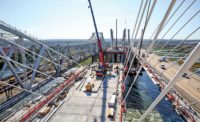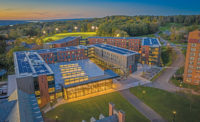When Brookfield Office Properties unveiled plans to develop a long dormant site on Manhattan's West Side last year, it would have been fair to question whether the global firm would complete the $4.6-billion project. After all, it had owned some parcels on the six-acre property spanning West 31st to West 33rd streets between 9th and 10th avenues for more than 15 years and had started and stopped development before on the property, where much of the "land" was a yawning pit over busy railroad tracks.
Brookfield served notice at the start, however, plowing $340 million of its own cash into the first $680-million phase of its 7-million-sq-ft Manhattan West project. And instead of leasing the complex machinery necessary to create a 115,000-sq-ft platform across the rail tracks, it simply bought the expensive, custom-built equipment outright.
"No one would purchase a crane to build a building," says Joseph Byrne, project executive at Turner Construction, construction manager on the Manhattan West platform, which was one of the region's top starts last year. "It is rare that an owner buys a piece of equipment. It would be rare even that a general contractor like Turner would purchase a piece of equipment."
Buying the equipment, called a launching gantry, which is now installing 240-ft-wide panels as part of the project's massive platform, allowed the developer to overcome the schedule, size and safety constraints of building over the tracks, says Henry Caso, a Brookfield vice president. In doing so, the firm was also buying certainty, reducing risk and avoiding the impact of more conventional methods, he says.
"We hope there will be someone interested in the launcher looking to develop over some other train yard somewhere in the world," Caso says. If not, he adds, Brookfield plans to sell the giant contraption for parts.
That kind of big thinking seems to anchor more than just the Manhattan West complex, which will include two 60-story office towers along with residential, retail and hospitality space. The project is emblematic of the type of downtown mixed-use developments that Brookfield is targeting, says Phil Wharton, senior vice president of development at the firm.
"We have a strong balance sheet and access to capital so we can take on some pretty big projects that most other developers would have difficulty taking on," he says. "Strategically, we're looking at opportunities in downtowns that are reviving. People are moving back into downtowns.… And when you do something on a large scale, you don't just want it to be just one type of use, for one type of customer."
Such diversity in the marketplace, coupled with a strong project pipeline and attention to environmental and community concerns helped ENR regional editors in their selection of Brookfield as the New York region's 2014 Owner of the Year.
Even if the Manhattan West project is overshadowed at times by the massive Hudson Yards development a few blocks to the west, Brookfield is feeding its appetite for acquisitions, renovation and ground-up development in its current slate of New York projects.
Its roster includes a $250-million renovation of retail and dining spaces at the former World Financial Center complex, which it has owned for years in lower Manhattan and recently redubbed Brookfield Place. It bought the New York Mercantile Exchange headquarters next door for $200 million in November and will rehabilitate and weave it into the larger property. The firm also is handling a nearly $14-million renovation project at its One New York Plaza property in lower Manhattan.
Brookfield is actively participating in the region's development rebound, Wharton says. "I think there's a lot of opportunity," he says. "Part of the reason is a lot of pent-up demand, where there wasn't financing available so a lot of construction was put on hold."
Still, the developer appears to have ramped up at the right time, at the tail end of a quiet procurement market, says Sabrina Kanner, Brookfield senior vice president of design and construction. "We were able to connect with the unions and have a great conversation with them," she says.
The firm employs the partnership approach on all of its projects, using a guaranteed maximum price model with distinct design and construction phases, Kanner says. "We believe in very intensive pre-con, and between construction pre-con and design there are a lot of iterations back and forth.… We very much believe in partnering all the way down to the subcontractor level and feel that we succeed every time when our interests are all aligned."
Brookfield engaged neighbors and elected officials on behalf of its Manhattan West project, in part because it knew that with the site lying fallow for years, it needed extra dialogue. "The kinds of things that concerned them were easily addressed—more information rather than less, and being up front," Kanner says.
The firm worked for three years with Community Board 4, participated in neighborhood quality-of-life meetings and implemented extensive communications, including weekly e-mails to the public about site activities. It monitored noise mitigation and worked with neighbors' concerns, including halting construction during student move-in and move-out days at the nearby Fashion Institute of Technology.
On the environmental front, the project includes extensive stormwater protection and retention and the use of locally sourced materials and suppliers. Brookfield aims for the project to achieve LEED-Gold status.
The firm also has focused on hiring minority- and women-owned enterprises, with a goal of having 20% representation on its projects, including the awarding of major trades on the platform to such firms, including its electrical subcontractor, Kleinberg Electric.
Brookfield's safety program includes tailored training for a railroad environment as well as multiple layers of prioritized safety communications. Its staff includes a licensed safety manager for each site who coordinates with the general safety manager, a provision that exceeds code requirements.
Those policies will get extensive use on Manhattan West, which will include a 65-story commercial office tower, a 60-story sibling tower and a 700,000-sq-ft residential tower. Overall, it will have 4 million sq ft of new construction, 2.1 acres of public space and an extensive $200-million renovation of the 1.8-million-sq-ft property at 450 W. 33rd St. that Brookfield acquired in 2011. That building—with REX as architect and Tishman Construction as construction manager on the rehabilitation—is getting reclad with a glass exterior and major upgrades to building systems and its lobby while tenants remain in place.
Manhattan West has roots in a property Brookfield acquired decades ago, Caso says. It later acquired more portions and started construction in 1997, but stopped when market conditions soured. Afterward, it acquired even more parcels.
The project is enormous even by New York standards, says Dick Anderson, president of the New York Building Congress. "The thing I like about it more than just generating work in the industry is that it's a real vote of confidence in the far West Side," he adds.
Jay Simson, president of the ACEC New York chapter, says that the design of the platform, by Toronto-based Entuitive and McNary Bergeron of Broomfield, Colo., is a showcase for high-end engineering. "If you think about the ability to transform such an area in demand, and the fact that they're going to build it while the trains are still running, it's pretty significant," he says.
The platform will serve as the bottom level of a parking deck about 25 ft above tracks serving New York's bustling Penn Station, Caso says. When rail agencies gave the team short time frames and restricted access, it led to the plan for the launcher. The approach is like bridge-building, creating 16 giant sections by attaching batches of 39 precast concrete panels, each 50 tons, with epoxy and post-tensioning.
The team is using the launcher, which moves on tracks and is currently situated on a temporary platform, to lift each 240-ft-wide span. With a four-week timetable to install each span, the entire platform will be in place by year's end, at which time construction on other site elements is set to begin, including one of the office towers and the 450 W. 33rd St. renovation. Much of the rest of the project will entail more conventional construction; the towers will rest mostly on bedrock, with some sections cantilevered over the platform, Caso says.
Wharton says when the first office tower and the residential tower come online in 2017 and once Manhattan West and the Hudson Yards projects are complete, the entire area will be "like a new city."








